

G-21st-Century-Classroom%20Assessment-Tool-0610. Local Districts. A Dozen Economic Facts About Education. Houston ISD. The Apollo 20 program is a bold initiative to transform public education in Houston and improve the academic achievement of all students.
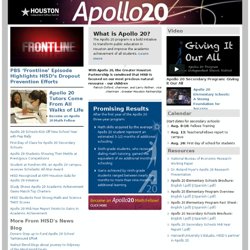
Learn more After the first year of the Apollo 20 three-year program: Math skills acquired by the average Apollo 20 student represent an estimated 3-1/2 months of additional schooling Sixth-grade students, who received dialing math tutoring, gained the equivalent of six additional months of schooling Gains achieved by ninth-grade students ranged between nearly five months to more than nine months of additional learning Participating schools. Snapshot of a modern learner. Santos is not an enigma, but he is misunderstood.
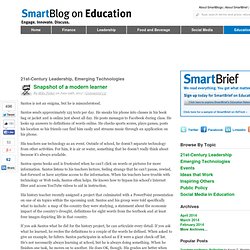
Santos sends approximately 125 texts per day. He sneaks his phone into classes in his book bag or jacket and is online just about all day. He posts messages to Facebook during class. He looks up answers to definitions of words online. He checks sports scores, plays games, posts his location so his friends can find him easily and streams music through an application on his phone. His teachers use technology as an event. Santos opens books and is frustrated when he can’t click on words or pictures for more information. His history teacher recently assigned a project that culminated with a PowerPoint presentation on one of six topics within the upcoming unit.
Are kids really motivated by technology? As a guy who delivers two-day #edtech workshops during my breaks from full-time classroom teaching, I’m often asked the same questions again and again: How can teachers use technology to motivate students?
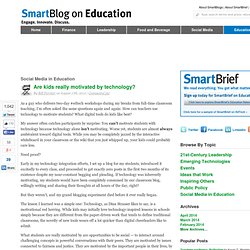
What digital tools do kids like best? My answer often catches participants by surprise: You can’t motivate students with technology because technology alone isn’t motivating. Worse yet, students are almost always ambivalent toward digital tools. While you may be completely jazzed by the interactive whiteboard in your classroom or the wiki that you just whipped up, your kids could probably care less. 2 things everyone wants SmartBlogs. School already has started for me.
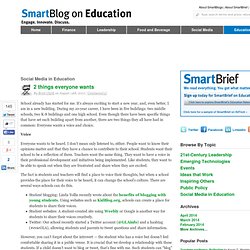
It’s always exciting to start a new year, and, even better, I am in a new building. During my 10-year career, I have been in five buildings: two middle schools, two K-8 buildings and one high school. Even though there have been specific things that have set each building apart from another, there are two things they all have had in common: Everyone wants a voice and choice. Voice Everyone wants to be heard. The fact is students and teachers will find a place to voice their thoughts, but when a school provides the place for their voice to be heard, it can change the school’s culture. Student blogging: Linda Yollis recently wrote about the benefits of blogging with young students. Replacing The Classroom-As-Factory With Collaborative Learning. I grew up going to Jewish Day schools.
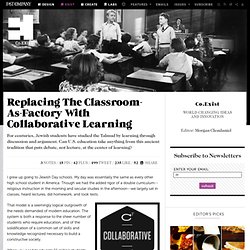
My day was essentially the same as every other high school student in America. Though we had the added rigor of a double curriculum--religious instruction in the morning and secular studies in the afternoon--we largely sat in classes, heard lectures, did homework, and took tests. That model is a seemingly logical outgrowth of the needs demanded of modern education. The system is both a response to the sheer number of students who require education, and of the solidification of a common set of skills and knowledge recognized necessary to build a constructive society. When you need to educate 55 million students spread out over 132,000 schools, as the U.S. did in 2010, the school-as-factory model becomes an apt idea.
Thinking that question through is what brings me back to the highlight of my Jewish school experience: Talmud class. Over the last few years, though, technology has begun to change the playing field. Flipped classrooms: Let’s change the discussion SmartBlogs. Since Sal Khan’s 2011 TED Talk, the Khan Academy has been nearly synonymous with “flipped classrooms.”
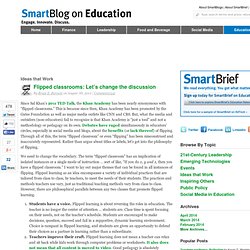
Moving away from one-size-fits-all learning, technology & spaces. What does the future of learning look like?

In the minds of many, it looks high tech and new—a complex array of technology and apps waiting to be woven into traditional curricula and classrooms. Others believe the future of learning should more closely mimic the ways people learned long ago—more collaboration, more Socratic dialogue, and more opportunities for hands-on discovery. At izzy+, we think the key is balancing the two—utilizing time-tested person-to-person learning approaches, along with the best advances technology has to offer. Brandon Reame, izzy+’s Market Development Strategist and education research guru, says schools and colleges just need to ensure that two critical components exist: a focus on people, and plenty of flexibility inherent in the learning spaces. Farmers for a Week: Taking Full Inclusion Outside the Classroom. For the second week in March, my fifth grade classroom was not filled with children reading and learning fractions.
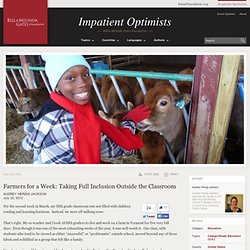
Instead, we were off milking cows. That’s right. My co-teacher and I took 18 fifth graders to live and work on a farm in Vermont for five very full days. What is a green school?